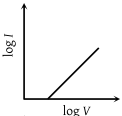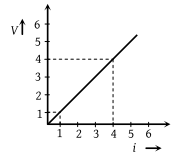When a current I is passed through a wire of constant resistance, it produces a potential difference V across its ends. The graph drawn between log I and log V will be
(1) 
(2) 
(3) 
(4) 




The V-I graph for a conductor at temperature T1 and T2 are as shown in the figure. is proportional to :
(1)
(2)
(3)
(4)
A cylindrical conductor has a uniform cross-section. The resistivity of its material increases linearly from the left end to the right end. If a constant current is flowing through it and at a section distance x from the left end, the magnitude of electric field intensity is E, which of the following graphs is correct :
(1)
(2)
(3)
(4)
The V-I graph for a conductor makes an angle θ with V-axis. Here V denotes the voltage and I denotes current. The resistance of the conductor is given by :
(1)
(2)
(3)
(4)
A battery consists of a variable number \('n'\) of identical cells having internal resistances connected in series. The terminals of battery are short circuited and the current \(i\) is measured. The graph below that shows the relationship between \(i\) and \(n\) is:
| 1. |  |
2. |  |
| 3. |  |
4. |  |
In an experiment, a graph was plotted of the potential difference V between the terminals of a cell against the circuit current I by varying load rheostat. Internal conductance of the cell is given by :
(1) xy
(2)
(3)
(4) (x – y)
A light bulb, a capacitor and a battery are connected together as shown below with the switch S initially open. When the switch S is closed, which one of the following is true?
1. The bulb will light up for an instant when
the capacitor starts charging.
2. The bulb will light up when
the capacitor is fully charged.
3. The bulb will not light up at all.
4. The bulb will light up and go off at regular intervals.
For a cell, the graph between the potential difference \((V)\) across the terminals of the cell and the current \((I)\) drawn from the cell is shown in the figure below. The emf and the internal resistance of the cell are, respectively:

| 1. | \(2~\text{V}, 0.5 ~\Omega\) | 2. | \(2~\text{V}, 0.4 ~\Omega\) |
| 3. | \(>2~\text{V}, 0.5 ~\Omega\) | 4. | \(>2~\text{V}, 0.4 ~\Omega\) |
Resistance as shown in figure is negative at
(1) A
(2) B
(3) C
(4) None of these
Variation of current and voltage in a conductor has been shown in the diagram below. The resistance of the conductor is :
(1) 4 ohm
(2) 2 ohm
(3) 3 ohm
(4) 1 ohm















